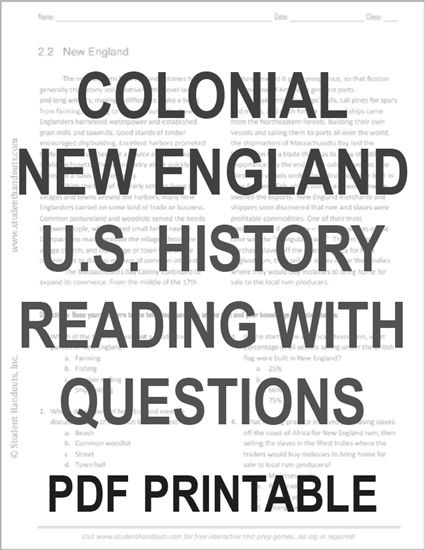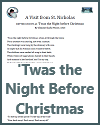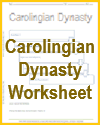| Colonial New England Reading with Questions |
|---|
| www.studenthandouts.com ↣ American History ↣ American History Readings |
 The northeastern New England colonies had generally thin, stony soil, relatively little level land, and long winters, making it difficult to make a living from farming. Turning to other pursuits, the New Englanders harnessed waterpower and established grain mills and sawmills. Good stands of timber encouraged shipbuilding. Excellent harbors promoted trade, and the sea became a source of great wealth. In Massachusetts, the cod industry alone quickly furnished a basis for prosperity.
The northeastern New England colonies had generally thin, stony soil, relatively little level land, and long winters, making it difficult to make a living from farming. Turning to other pursuits, the New Englanders harnessed waterpower and established grain mills and sawmills. Good stands of timber encouraged shipbuilding. Excellent harbors promoted trade, and the sea became a source of great wealth. In Massachusetts, the cod industry alone quickly furnished a basis for prosperity.With the bulk of the early settlers living in villages and towns around the harbors, many New Englanders carried on some kind of trade or business. common pastureland and woodlots served the needs of townspeople, who worked small farms nearby. compactness made possible the village school, the village church, and the village or town hall, where citizens met to discuss matters of common interest. The Massachusetts Bay Colony continued to expand its commerce. From the middle of the 17th century onward it grew prosperous, so that Boston became one of America's greatest ports. Oak timber for ships' hulls, tall pines for spars and masts, and pitch for the seams of ships came from the Northeastern forests. Building their own vessels and sailing them to ports all over the world, the shipmasters of Massachusetts Bay laid the foundation for a trade that was to grow steadily in importance. By the end of the colonial period, one-third of all vessels under the British flag were built in New England. Fish, ship's stores, and woodenware swelled the exports. New England merchants and shippers soon discovered that rum and slaves were profitable commodities. One of their most enterprising—if unsavory—trading practices of the time was the "triangular trade." Traders would purchase slaves off the coast of Africa for New England rum, then sell the slaves in the West Indies where they would buy molasses to bring home for sale to the local rum producers. Directions: Read the text above, then answer the questions below. Answers are in bold. 1. Which of the following was not a productive pursuit in New England? a. Farming b. Fishing c. Lumber milling d. Shipbuilding 2. Where did citizens of New England meet to discuss matters of common local interest? a. Beach b. Common woodlot c. Street d. Town hall 3. By the start of the American Revolution, what percentage of all vessels sailing under the British flag were built in New England? a. 25% b. 33% c. 66% d. 75% 4. What trading practice involved purchasing slaves off the coast of Africa for New England rum, then selling the slaves in the West Indies where the traders would buy molasses to bring home for sale to local rum producers? a. Molasses trade b. Rum trade c. Slave trade d. Triangular trade Click here to print this worksheet. |
 |  |  |  |  |  |
| Colonial Period Books and Films | Colonial Period Learning and Study Games |
| Colonial Period Image Galleries | Colonial Period Outlines and PowerPoints |
| Colonial Period Miscellany | Colonial Period Worksheets |
| www.studenthandouts.com ↣ American History ↣ American History Readings |








